GEWA HP eight
Published: June-16-2023
NO SMOOTHING is applied to the shown plots. Most measurement sites have some smoothing applied which ‘irons flat’ sharp peaks and ‘wiggles’. I do not use smoothing because some info about sound quality is lost when plots are smoothed.
Aside from a small correction of the microphone itself also some correction in the lowest frequencies is applied to the plots to compensate for the perceived loss of bass when using headphones. This is described HERE in more detail.
A ‘horizontal‘ frequency response curve on the shown frequency response plots on this website thus indicates a perceived ‘flat’ tonal signature.
ALL measurements are made with a good SEAL on a flatbed measurement rig.
The shape of your head, bone structure, pad size, pad ‘softness, (compliance), hair or no hair and or wearing glasses may (drastically) change the frequency response of some headphones, so… your personal experience may differ substantially from these plots.
Frequency response (tonal balance) is the most sound-determining aspect of headphones. A horizontal line shows audible neutral response in the plots on this website. Deviations in different severity at different frequency bands have an effect on the sound character.
The bigger the deviation the stronger the effect.
Below an aid to help determining the sound character of headphones with relation to the frequency response.

GEWA HP eight
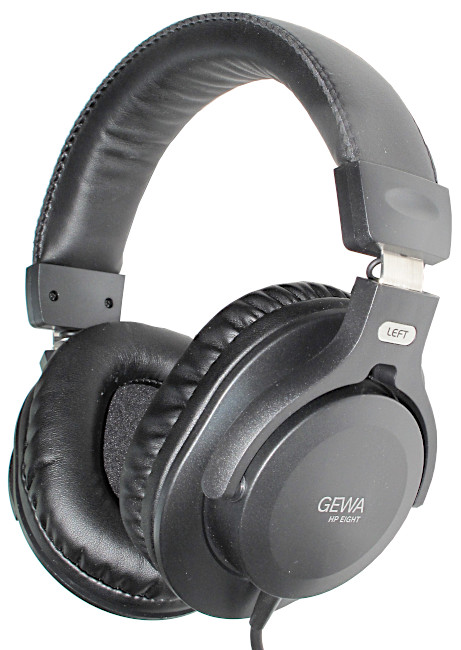 The GEWA HP eight is a closed over-ear headphone and sells for around €40.-
The GEWA HP eight is a closed over-ear headphone and sells for around €40.-
It is the little brother of the somewhat more expensive HP nine-X which has 2 replaceable cables, spare pads and a travel case. The HP nine-X is the same headphone as the Devine PRO 4000.
The build quality is good given its price.
The HP eight has a fixed cable and pouch for storage.
The cups can be rotated 180 degrees and have enough swivel to create a good fit. The headphone comes with 3 meter long fixed (not replaceable) cable terminated in a goldplated 3.5mm TRS jack with nickel-plate push-on 6.3mm adapter. The cable is mildly microphonic. This means touching the cable and it rubbing against clothes is slightly audible in the left cup.
This headphone does not fold flat nor can it be collapsed into the headband.
The cups can tilt and swivel far enough for a comfortable fit on most heads. The headband is pleather covered and feels soft enough and is wide enough not to create hot-spots on the head. The headband can be adjusted/extended over a decent range (38mm).
The clamping force is on the high side with its 4N.
The replaceable pads have firm regular foam inside and are covered with pleather (PVC covered cloth). Room for the ears is not plenty though. The pads have a 55mm height, 40mm width and 19mm depth is enough for most ears. Chances are the ears touch the pads when one has bigger ears. A bit bigger pads would have been preferable.
When the room temperature is a bit higher the pads feel sweaty and sticky.
The sensitivity is good (118dB/V) and with its 35Ω impedance it can play pretty loud even from portable sources like phones etc. Even with EU phones with output power restrictions it can play loud enough.
The HP eight is meant to be a cheap closed monitor headphone with decent build quality and that’s what it does quite well.
Isolation is not very good though but offers some attenuation from outside.
This headphone is low in weight 207 gr (without the cable).
specifications:
Type: Over-ear(supra-aural), closed
Usage: Home, Portable
Isolation: medium
Driver type: dynamic
Pads: replaceable, pleather
Inner pad dimensions: Height: 55mm, width: 40 mm, depth: 19mm, oval shaped
Collapsible: no
Headphone connector: fixed cable
Cable: 3m straight with gold plated 3.5mm TRS plug + nickel-plated 6.3 mm push-on adapter
Driver size: ø 38mm
Max. power rating: 0.2W
Max. voltage: 2.6V
Max. current: 75mA
Max. S.P.L.: 128dB
Impedance: 35Ω (measured)
Sensitivity: 118dB @ 1V
Efficiency: 103dB @ 1mW
Weight: 207g. (without cable) 245g. with cable.
Color: black
Clamping force: medium-high (3.5-4N)
Accessories: 6.3mm adapter + pouch
Sound description:
The sound is powerful, deep but lacking in clarity and fine nuances/treble extension.
Bass is not of high quality but very well extended. The bass reaches very deep, well below 10Hz even. The bass is not ‘tight’.
The overall sound is full but overly warm. Mids lack clarity and sound a bit dull.
Treble is present but a bit low in level and quality (coarse and lacking sparkle and ‘details’).
This is fine when using it for monitoring at somewhat higher listening levels.
Not a headphone that can be used for enjoying quality music.
measurements:
Below the frequency response of the HP eight (left, right)
Channel matching is reasonable and as could be expected in this price class. Bass response goes very deep, when a good seal is achieved.
Bass and lower mids are accentuated a bit. From 1kHz upward the response drops which is causing the lack of clarity.
Below the phase response of the HP eight (left, right)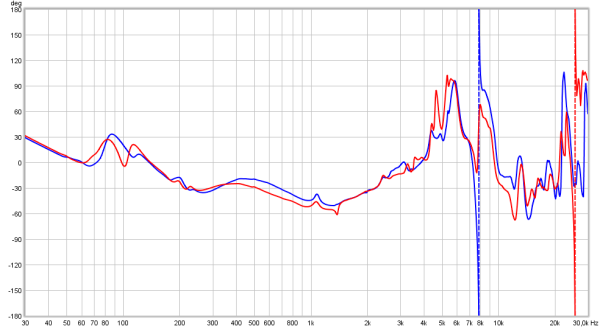
Slow phase shifts are not very audible. Steep changes in a narrow frequency bands may well be audible. Above 4kHz there are many substantial variances in narrow frequency bands which also point to a low treble quality. Not much of a problem when using it as a monitor.
Seal
Seal is quite important for closed headphones and this headphone is no exception. Below the effect on the tonal balance is shown when the seal is not perfect. The bass suffers. Perfect seal, seal broken with thick armed glass resting against the skin, seal broken with thin armed glasses not resting against the skin, seal broken by thick armed glasses that are not flush against the skin, seal broken when slightly lifting the pads.
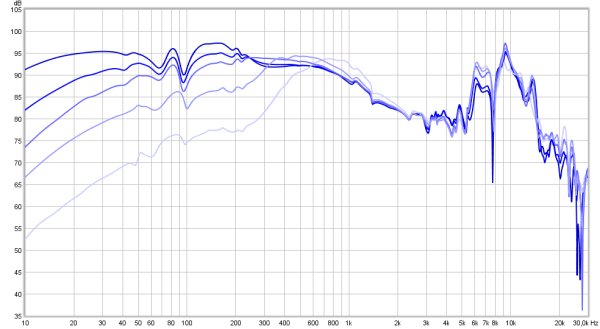 Breaking the seal lowers the amount of bass. A small leakage (hairs, arms of glasses resting against the skin) is not that audible. Breaking the seal a bit more than that results in an audible bass roll-off to no bass at all. Having a good to decent seal is essential for this headphone.
Breaking the seal lowers the amount of bass. A small leakage (hairs, arms of glasses resting against the skin) is not that audible. Breaking the seal a bit more than that results in an audible bass roll-off to no bass at all. Having a good to decent seal is essential for this headphone.
Comparison
Below the HP eight versus some other closed headphones.

output resistance / damping-factor
As this is a closed dynamic headphone the frequency response can be amplifier output resistance dependent when certain higher output resistance amplifiers are used.
Instead of showing impedance plots, which are hard to ‘read’ when it comes to assessing the tonal balance change in the real world, the HP5 is measured via a few different resistance outputs (0.2Ω, 10Ω, 32Ω and 120Ω). On a higher output resistance amplifier the output level will be lower of course due to voltage division. To compensate for this the amplifier is turned up to the same level (13.8dB for 120Ω at 1kHz in this case at max. volume setting). This way the plots are overlaid and it is easier to see how the tonal balance changes.  The headphone does not react a bit to higher output resistances. The resonance frequency is around 50Hz. The tonal balance is not changed much when using a higher output resistance. This means it can be used from various interfaces and music instruments as these often have output impedance that can range between 10Ω and 100Ω but interfaces with an output resistance above 50Ω is not recommended.
The headphone does not react a bit to higher output resistances. The resonance frequency is around 50Hz. The tonal balance is not changed much when using a higher output resistance. This means it can be used from various interfaces and music instruments as these often have output impedance that can range between 10Ω and 100Ω but interfaces with an output resistance above 50Ω is not recommended.
distortion
Below the distortion measurements of the HP eight (right channel) at 90dB SPL.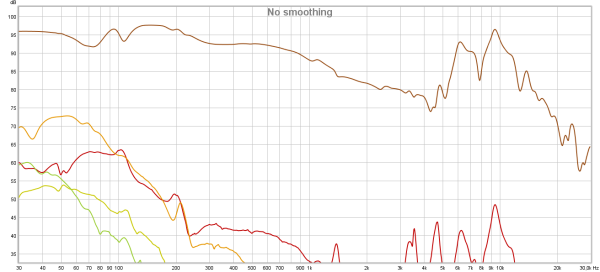
Below the same distortion plot but with the vertical scale in percentages instead of level differences.
Distortion at 95dB SPL (around 50 Hz) is a quite high (10%) and is both 2nd and 3rd harmonic.
The distortion around 3kHz and 5kHz reaches 1%. The fact that in the lower frequencies the odd order harmonics are higher than the even harmonics indicates compression (the peak levels are not reproduced as loud as lower levels in the bass.
The 2nd harmonic distortion above 400Hz is may be lower than shown as limits of the test rig are around 0.2%.
The distortion is lower when the listening level is lower as well. Below 80dB average levels.
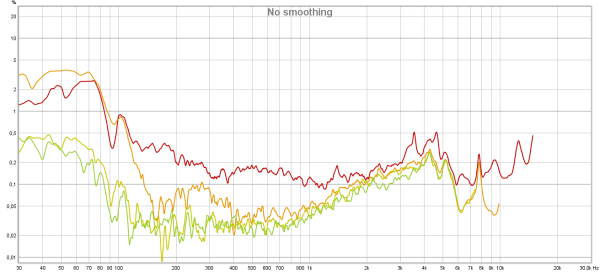 The distortion at lower frequencies is still over 2% but is not a very audible level.
The distortion at lower frequencies is still over 2% but is not a very audible level.
Below the distortion at 70dB average level.
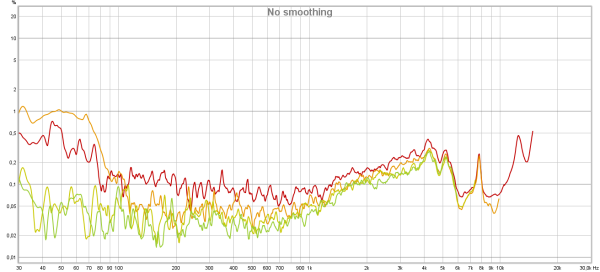 Even at lower levels there still is an unusual high distortion level.
Even at lower levels there still is an unusual high distortion level.
Linearity
To see how severe the compression is the HP eight is measured 5 times. Once at 60dB, 70dB, 80dB, 90dB and 96dB SPL (at 1kHz). When the traces are overlaid and have the same shape then there is no compression visible.
Note: the 2dB/div scale.
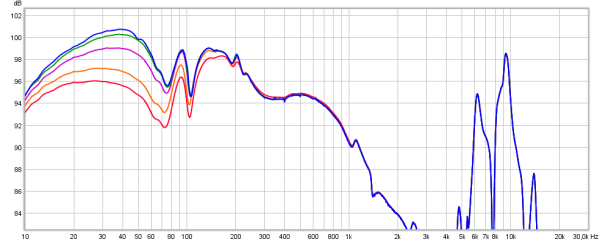
At louder levels the bass is reproduced 4dB too low compared to normal listening levels.
Above 70dB compression starts to occur. This is also seen in the distortion plots above.
Below the CSD of the HP eight (left and right are overlaid).
The driver has very short lived resonances. No red flags in this aspect.
Below the spectrum plot of the HP eight (left channel).
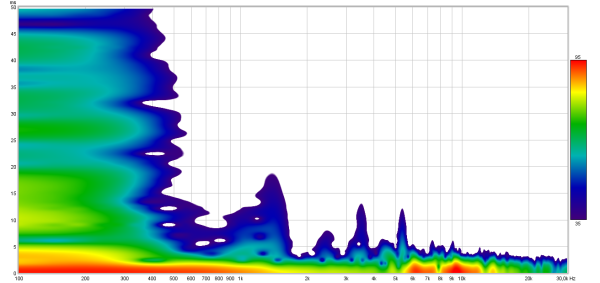 There is a resonance at around 1.5kHz. Possibly a cup resonance. Below 300Hz the lower frequencies linger on a bit longer than desirable and can be indicative for poorer bass quality.
There is a resonance at around 1.5kHz. Possibly a cup resonance. Below 300Hz the lower frequencies linger on a bit longer than desirable and can be indicative for poorer bass quality.
Below the group delay plot of the HP eight (left, right)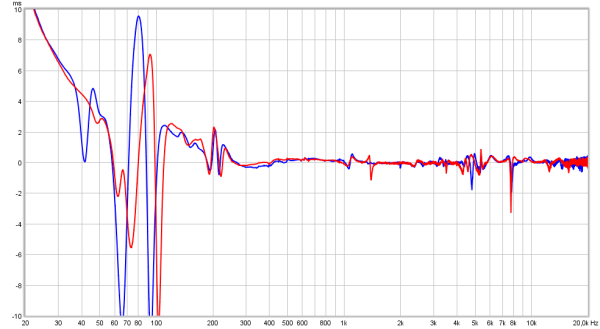 Between 60Hz and 110Hz there is quite some ‘pad bounce’. This is energy that goes into the foam of the pads and is reflected and absorbed at some frequencies. Also at 200Hz, 5kHz and 8kHz there are some resonances.
Between 60Hz and 110Hz there is quite some ‘pad bounce’. This is energy that goes into the foam of the pads and is reflected and absorbed at some frequencies. Also at 200Hz, 5kHz and 8kHz there are some resonances.
Remember, this is a cheap monitoring headphone and not intended for music enjoyment.
The step response of the HP eight (left, right)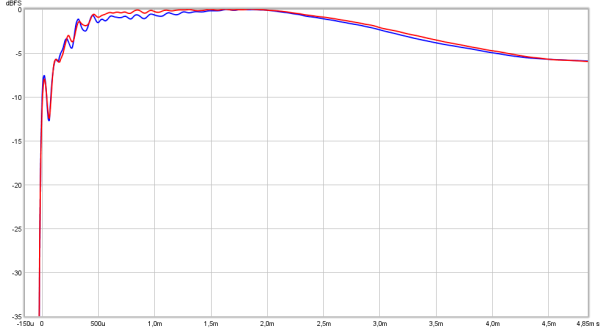
The initial rise comes up 8dB ‘short. The slow rise in the first ms shows the bassy and dark sound character of this headphone and lack of ‘bite’ and clarity. After 400μs the response is at the correct level. The hardly sloping horizontal part shows the excellent subbass extension (with a perfect seal)
Pad change and modifications
To increase the comfort and sound quality some easy and reversible modifications can be done.
As this headphone is very similar to the Devine Pro 4000 the modifications that can be done to improve the sound quality to a higher level can be found in the Devine Pro 4000 article.
Below pictures of the front side of the HP eight, Devine Pro 4000 and on the right the headphone where the OEM manufacturer that makes these headphones got the inspiration from.
 The resemblance is striking. The GEWA uses black acoustic paper behind the holes.
The resemblance is striking. The GEWA uses black acoustic paper behind the holes.
Below the backside of the drivers.
 The same drivers have been used in the HP eight and Devine Pro 4000. Of course the driver used in the Audio Technica is very different (not shown).
The same drivers have been used in the HP eight and Devine Pro 4000. Of course the driver used in the Audio Technica is very different (not shown).
It is clear that the GEWA and Devine headphones come from the same OEM manufacturer.
The headband of the GEWA is the same one as used in the fun generation HP5 headphone.
summary
The GEWA HP eight is a cheap closed headphone of decent build quality.
It is sold as a monitoring headphone and does that job. Don’t expect this to be a cheap but excellent headphone because it is professional monitoring headphone.
The clamping force is high. Pads can become a bit sticky and sweaty. The used pleather on the pads and headband is not going to have a long life. The pads can easily be replaced, the headband can not.
This is not a headphone suited for music enjoyment as is… but… with some (reversible) simple mods and the purchase of a pair of Shure earpads, that cost about as much as the headphone itself, this headphone can be used as a decent closed headphone. Don’t expect top notch sound quality after the modifications have been done.
